On the Convenience of Using Simulation Models to Optimize the Control Strategy of Molten-Salt Heat Storage Systems in Solar Thermal Power Plants
Abstract
:1. Introduction
- Automatic control of the variables involved in the process.
- Automatic control of the operation mode.
- Automatic control of the operation strategy.
2. Materials and Methods
2.1. Control Strategies Considered
- PID control with feed-forward
- Advanced PID control with feed-forward
- Adaptive-predictive control with feed-forward
2.1.1. PID Control with Feed-Forward
- Perturbations are measurable.
- The equations relating the perturbations and the control variables of the process to be regulated are known.
2.1.2. Advanced PID Control with Feed-Forward
- Estimating the temperature reference, i.e., the set point for the hot-HTF temperature, SPTHTFH.
- Estimating the temperature of the cold salt, TSaltC_CAL, at the output of the heat exchanger.
2.1.3. Adaptive-Predictive Control with Feed-Forward
- The estimated salt flow, , is now a perturbation signal for the regulator, which allows for the dynamics of such a perturbation to be considered by the control system.
- The actual value of the control variable, , is measured and fed back into the regulator. This allows the system to include the dynamics of the other PID regulators (valves, frequency converters of the pumps).
3. Results
3.1. Simulation of the TES-System Control Strategies
3.2. Experimental Results
- Tests are to be performed on summer sunny days, when there is an excess of solar energy that cannot be used in the turbine and, therefore, must be stored.
- Each test lasts for a whole day during which the TES system is fully charged and then fully discharged.
- Since daily conditions may differ from one test to another, all the control strategies are tested several times so as to reduce the influence of such variable conditions.
- When the discharge begins, the plant counter of energy sold is consulted.
- The TES is fully discharged while the turbine is operating at full power. If at the end of the discharge the salt level in the hot tank is higher than one meter, the discharge will be considered to be incomplete and the test will be disregarded.
- At the end of the discharge, the plant counter of energy sold is read again. The difference between this reading and the one made at the beginning of the discharge will provide the net energy generated with the control strategy under test. The net energy provided during these discharges will be used to evaluate the performance of the control strategy implemented.
- For every successful discharge, the most relevant meteorological conditions during the test are written down for later use in simulations.
4. Discussion
5. Conclusions
Acknowledgments
Author Contributions
Conflicts of Interest
References
- British Petroleum. BP Statistical Review of World Energy 2016; BP p.l.c.: London, UK, 2016. [Google Scholar]
- Yang, Z.; Garimella, S.V. Cyclic operation of molten-salt thermal energy storage in thermoclines for solar power plants. Appl. Energy 2013, 103, 256–265. [Google Scholar] [CrossRef]
- Usaola, J. Operation of concentrating solar power plants with storage in spot electricity markets. IET Renew. Power Gener. 2012, 6, 59–66. [Google Scholar] [CrossRef]
- Lillo, I.; Pérez, E.; Moreno, S.; Silva, M. Process Heat Generation Potential from Solar Concentration Technologies in Latin America: The Case of Argentina. Energies 2017, 10, 383. [Google Scholar] [CrossRef]
- Hassine, I.B.; Sehgelmeble, M.C.; Söll, R.; Pietruschka, D. Control optimization through simulations of large scale solar plants for industrial heat applications. Energy Procedia 2015, 70, 595–604. [Google Scholar] [CrossRef]
- Tian, Y.; Zhao, C.Y. A review of solar collectors and thermal energy storage in solar thermal applications. Appl. Energy 2013, 104, 538–553. [Google Scholar] [CrossRef]
- Zhang, H.L.; Baeyens, J.; Degrève, J.; Cacères, J. Concentrated solar power plants: Review and design methodology. Renew. Sustain. Energy Rev. 2013, 22, 466–481. [Google Scholar] [CrossRef]
- Kaltschmitt, M.; Wolfgang, S.; Andreas, W. Solar Thermal Power Plants. In Renewable Energy; Springer: Berlin/Heidelberg, Germany, 2007; pp. 171–228. [Google Scholar]
- Schnatbaum, L. Solar thermal power plants. Eur. Phys. J. Spec. Top. 2009, 176, 127–140. [Google Scholar] [CrossRef]
- Wu, S.Y.; Xiao, L.; Cao, Y.; Li, Y.R. A parabolic dish/AMTEC solar thermal power system and its performance evaluation. Appl. Energy 2010, 87, 452–462. [Google Scholar] [CrossRef]
- Saleem, S.; Asar, A. Analysis & Design of Parabolic Trough Solar Thermal Power Plant for Typical Sites of Pakistan. IOSR J. Electr. Electron. Eng. (IOSR-JEEE) 2014, 9, 116–122. [Google Scholar]
- Silva, R.; Cabrera, F.J.; Pérez-García, M. Process heat generation with parabolic trough collectors for a vegetables preservation industry in Southern Spain. Energy Procedia 2014, 48, 1210–1216. [Google Scholar] [CrossRef]
- Jebasingh, V.K.; Joselin Herbert, G.M. A review of solar parabolic trough collector. Renew. Sustain. Energy Rev. 2016, 54, 1085–1091. [Google Scholar] [CrossRef]
- Lamba, D.K. Review on Parabolic Trough Type Solar Collectors: Innovation, Applications and Thermal Energy Storage. In Proceedings of the National Conference on Trends and Advances in Mechanical Engineering, YMCA University of Science & Technology, Faridabad, Haryana, 19–20 October 2012. [Google Scholar]
- Desai, N.B.; Bandyopadhyay, S. Optimization of concentrating solar thermal power plant based on parabolic trough collector. J. Clean. Prod. 2015, 89, 262–271. [Google Scholar] [CrossRef]
- Eck, M.; Hennecke, K. Heat Transfer Fluids for Future Parabolic Trough Solar Thermal Power Plants. In Proceedings of the ISES World Congress, Beijing, China, 18–21 September 2007. [Google Scholar]
- Ter-Gazarian, A.G. Thermal Energy Storage. In Energy Storage for Power Systems, 2nd ed.; IET Press: Stevenage, UK, 2011; pp. 55–76. [Google Scholar]
- Chen, H.; Cong, T.N.; Yang, W.; Tan, C.; Li, Y.; Ding, Y. Progress in electrical energy storage system: A critical review. Prog. Nat. Sci. 2009, 19, 291–312. [Google Scholar] [CrossRef]
- Luo, X.; Wang, J.; Dooner, M.; Clarke, J. Overview of current development in electrical energy storage technologies and the application potential in power system operation. Appl. Energy 2015, 137, 511–536. [Google Scholar] [CrossRef]
- 20 MW/80 MWh-Energy Nuevo-Amber Kinetics, “DOE International Energy Storage Database”. Available online: http://www.energystorageexchange.org/projects/1975 (accessed on 6 July 2017).
- Central Hidroeólica de El Hierro, “Noticias del Meridiano”. Available online: http://www.elhierro.tv/noticias/008_01_20/008_01_20.html (accessed on 6 July 2017).
- Markersbach Pumped Storage Power Plant, “DOE International Energy Storage Database”. Available online: http://www.energystorageexchange.org/projects/402 (accessed on 6 July 2017).
- 110-Megawatt Compressed Air Energy Storage facility, “Power South Energy Cooperative”. Available online: http://www.powersouth.com/mcintosh_power_plant/compressed_air_energy (accessed on 6 July 2017).
- Southern California Edison-Chino Battery Storage Project, “DOE International Energy Storage Database”. Available online: http://www.energystorageexchange.org/projects/2186 (accessed on 6 July 2017).
- Laing, D.; Steinmann, W.D.; Tamme, R. Sensible Heat Storage for Medium and High Temperatures. In Proceedings of the ISES World Congress, Beijing, China, 18–21 September 2007. [Google Scholar]
- Goods, S.H.; Bradshaw, R.W. Corrosion of stainless steels and carbon steel by molten mixtures of commercial nitrate salts. J. Mater. Eng. Perform. 2004, 13, 78–87. [Google Scholar] [CrossRef]
- USA Trough Initiative. Thermal Storage Oil-to-Salt Heat Exchanger Design and Safety Analysis; Task Order Au. No. KAF-9-29765-09; Nexant Inc.: San Francisco, CA, USA, 2000. [Google Scholar]
- Llorente García, I.; Álvarez, J.L.; Blanco, D. Performance model for parabolic trough solar thermal power plants with thermal storage: Comparison to operating plant data. Sol. Energy 2011, 85, 2443–2460. [Google Scholar] [CrossRef]
- Powell, K.M.; Edgar, T.F. Modeling and control of a solar thermal power plant with thermal energy storage. Chem. Eng. Sci. 2012, 71, 138–145. [Google Scholar] [CrossRef]
- Menéndez, R.P.; Martínez, J.Á.; Prieto, M.J.; Barcia, L.Á.; Sánchez, J.M.M. A Novel Modeling of Molten-Salt Heat Storage Systems in Thermal Solar Power Plants. Energies 2014, 7, 6721–6740. [Google Scholar] [CrossRef]
- Peón, R.; Requena, R.; Martín Sánchez, J.M. Optimized Adaptive Control for CSP plants. In Proceedings of the 2nd International Concentrated Solar Power Summit, Madrid, Spain, 5–6 June 2012. [Google Scholar]
- Ma, Z.; Glatzmaier, G.; Turchi, C.; Wagner, M. Thermal energy storage performance metrics and use in thermal energy storage design. In Proceedings of the Colorado ASES World Renewable Energy Forum, Denver, CO, USA, 13–17 May 2012. [Google Scholar]
- Aneke, W.; Wang, M. Energy storage technologies and real life applications—A state of the art review. Appl. Energy 2016, 179, 350–377. [Google Scholar] [CrossRef]
- Mathur, A.; (Terrafore Technologies, Minneapolis, USA). Dynamic Models of Concentrated Solar Power Plant to Response to Utility Demand Profiles. 2014. Available online: http://www.terraforetechnologies.com/wp-content/uploads/2014/02/Dynamic-Models-of-Concentrated-Solar-Power-Plant-to-Response-to-Utility-Demand-Profiles1.pdf (accessed on 6 July 2017).
- Torras, S.; Pérez-Segarra, C.; Rodríguez, I.; Rigola, J.; Oliva, A. Parametric study of two-tank TES systems for CSP plants. In Proceedings of the SOLARPACES 2014, Beijing, China, 16–19 September 2014. [Google Scholar]
- Modi, A.; Perez-Segarra, C.D. Thermocline thermal storage systems for concentrated solar power plants: One dimensional numerical model and comparative analysis. Sol. Energy 2014, 100, 84–93. [Google Scholar] [CrossRef]
- Bayón, R.; Rojas, E. Simulation of thermocline storage for solar thermal power plants: From dimensionless results to prototypes and real-size tanks. Int. J. Heat Mass Transf. 2013, 60, 713–721. [Google Scholar] [CrossRef]
- Flueckiger, S.M.; Iverson, B.D.; Garimella, S.V.; Pacheco, J.E. System-level simulation of a solar power tower plant with thermocline thermal energy storage. Appl. Energy 2014, 113, 86–96. [Google Scholar] [CrossRef]
- Wojcik, J.D.; Wang, J. Technical Feasibility Study of Thermal Energy Storage Integration into the Conventional Power Plant Cycle. Energies 2017, 10, 205. [Google Scholar] [CrossRef]
- Edwards, J.; Bindra, H.; Sabharwall, P. Exergy analysis of thermal energy storage options with nuclear power plants. Ann. Nucl. Energy 2016, 96, 104–111. [Google Scholar] [CrossRef]
- Li, G.; Zheng, X. Thermal energy storage system integration forms for a sustainable future. Renew. Sustain. Energy Rev. 2016, 62, 736–757. [Google Scholar] [CrossRef]
- Martín, L.; Zarzalejo, L.F.; Polo, J.; Navarro, A.; Marchante, R.; Cony, M. Prediction of global solar irradiance based on time series analysis: Application to solar thermal power plants energy production planning. Sol. Energy 2012, 84, 1772–1781. [Google Scholar] [CrossRef]
- Álvarez Barcia, L.; Peón Menéndez, R.; Martínez Esteban, J.Á.; José Prieto, M.Á.; Martín Ramos, J.A.; Cos Juez, F.J.; Nevado Reviriego, A. Dynamic Modeling of the Solar Field in Parabolic Trough Solar Power Plants. Energies 2015, 8, 13361–13377. [Google Scholar] [CrossRef]
- Roca, L.; Bonilla, J.; Rodríguez García, M.M.; Palenzuela, P.; Calle, A.; Valenzuela, L. Control strategies in a thermal oil—Molten salt heat exchanger. In Proceedings of the SOLARPACES 2015, Cape Town, South Africa, 13–16 October 2015; American Institute of Physics: Melville, NY, USA, 2016. [Google Scholar]
- Qenawy, M. Matlab Simulation of 10 MW Molten Salt Solar Power Tower Plant in Aswan. Noble Int. J. Sci. Res. 2017, 1, 34–43. [Google Scholar]
- Martín-Sánchez, J.M.; Rodellar, J. Adaptive Predictive Control: From the Concepts to Plant Optimization, 1st ed.; Prentice Hall: Upper Saddle River, NJ, USA, 1995. [Google Scholar]
- Martín-Sánchez, J.M.; Rodellar, J. Control Adaptativo Predictivo Experto: Metodología, Diseño y Aplicación; Universidad Nacional de Educación a Distancia: Madrid, Spain, 2005. [Google Scholar]
- Martín-Sánchez, J.M.; Rodellar, J. Estrategia básica de control predictivo. In Control Adaptativo Predictivo Experto ADEX. Metodología, Diseño y Aplicación; UNED: Madrid, Spain, 2005; pp. 83–102. [Google Scholar]
- Kandare, G.; Viúdez-Moreiras, D.; Hernández-del-Olmo, F. Adaptive control of the oxidation ditch reactors in a wastewater treatment plant. Int. J. Adapt. Control Signal Process. 2012, 26, 976–989. [Google Scholar] [CrossRef]
- Nevado, A.; Requena, R.; Polo, P. Un control adaptativo predictivo experto para una E.D.A.R. Autom. Instrum. 2010, 415, 50–53. [Google Scholar]
- Nevado, A.; Requena, R.; Videz, D.; Plano, E. A new control strategy for IKN-type coolers. Control Eng. Pract. 2011, 19, 1066–1074. [Google Scholar] [CrossRef]
- Requena, R.; Nevado, A.; Martín, J.M. Control optimizado para la red eléctrica de España. Autom. Instrum. 2009, 407, 14–23. [Google Scholar]
- Astrom, K.J.; Wittenmark, B. Adaptive Control, 2nd ed.; Addison-Wesley: Boston, MA, USA, 1995. [Google Scholar]
- Adaptive Predictive Control. Available online: http://www.adexcop.com/adaptive (accessed on 6 July 2017).
- Peón, R. Optimización del Control del Sistema de Almacenamiento Térmico en Centrales Solares Termoeléctricas. Ph.D. Thesis, Universidad de Oviedo, Asturias, Spain, June 2012. [Google Scholar]

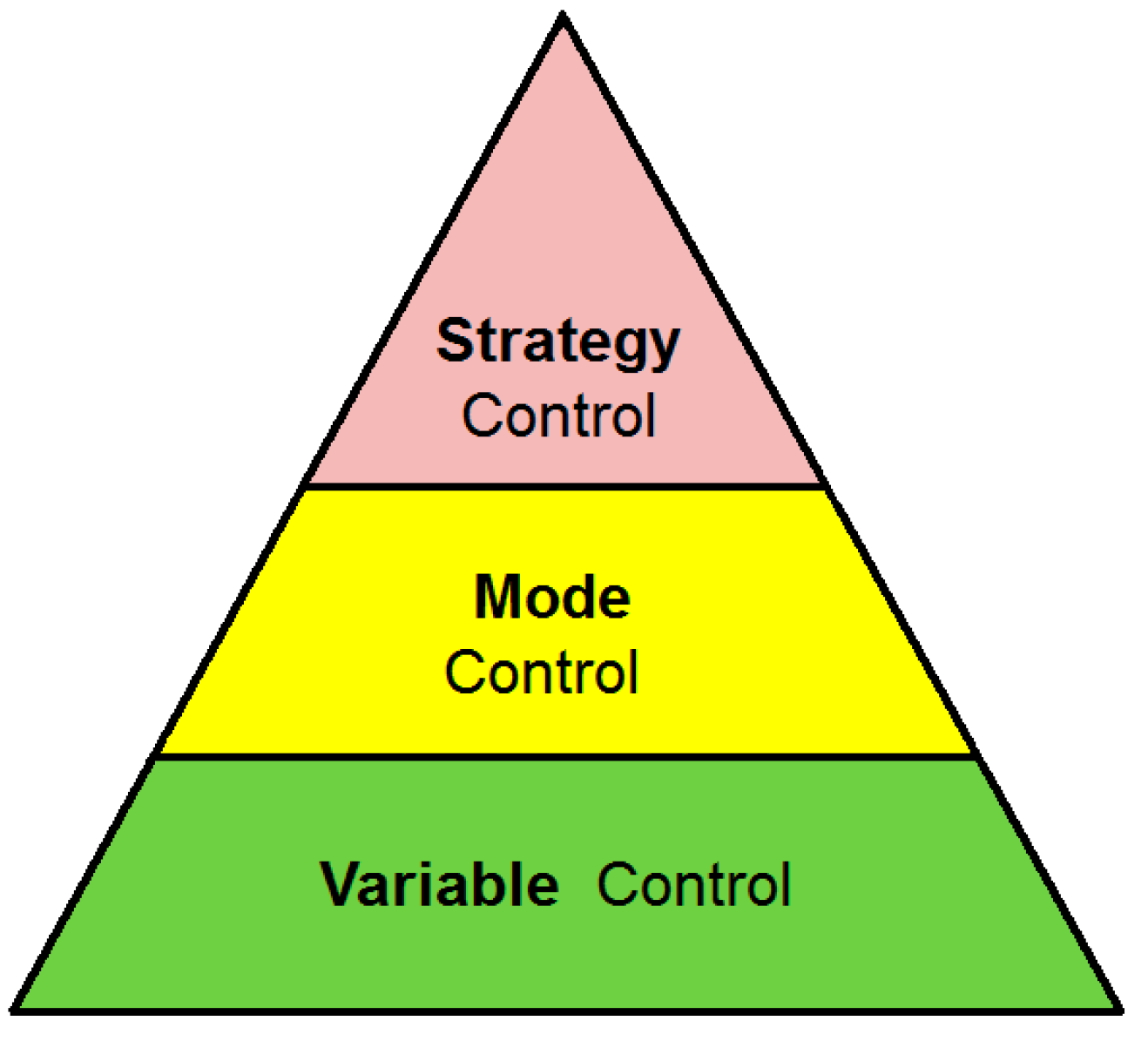


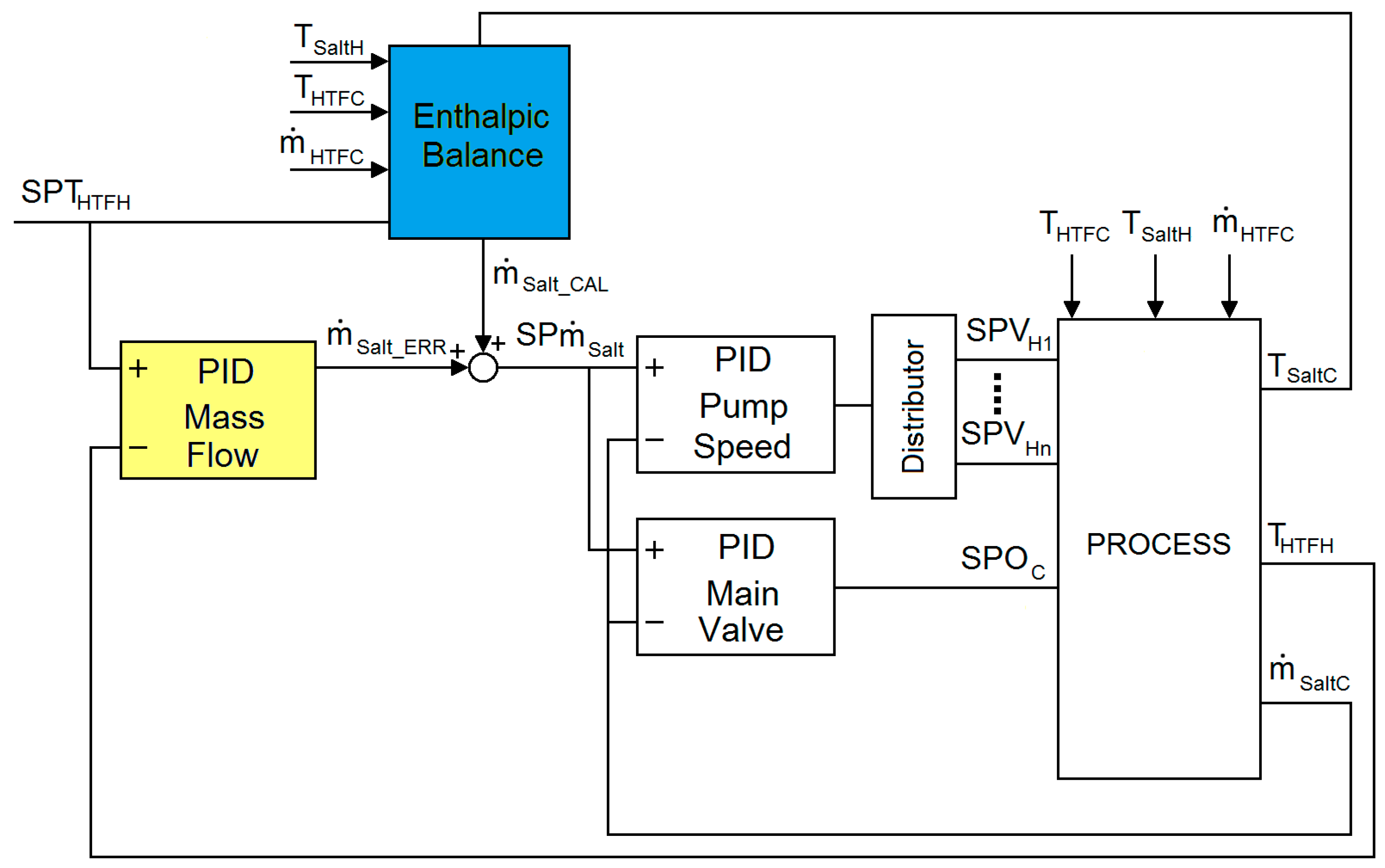
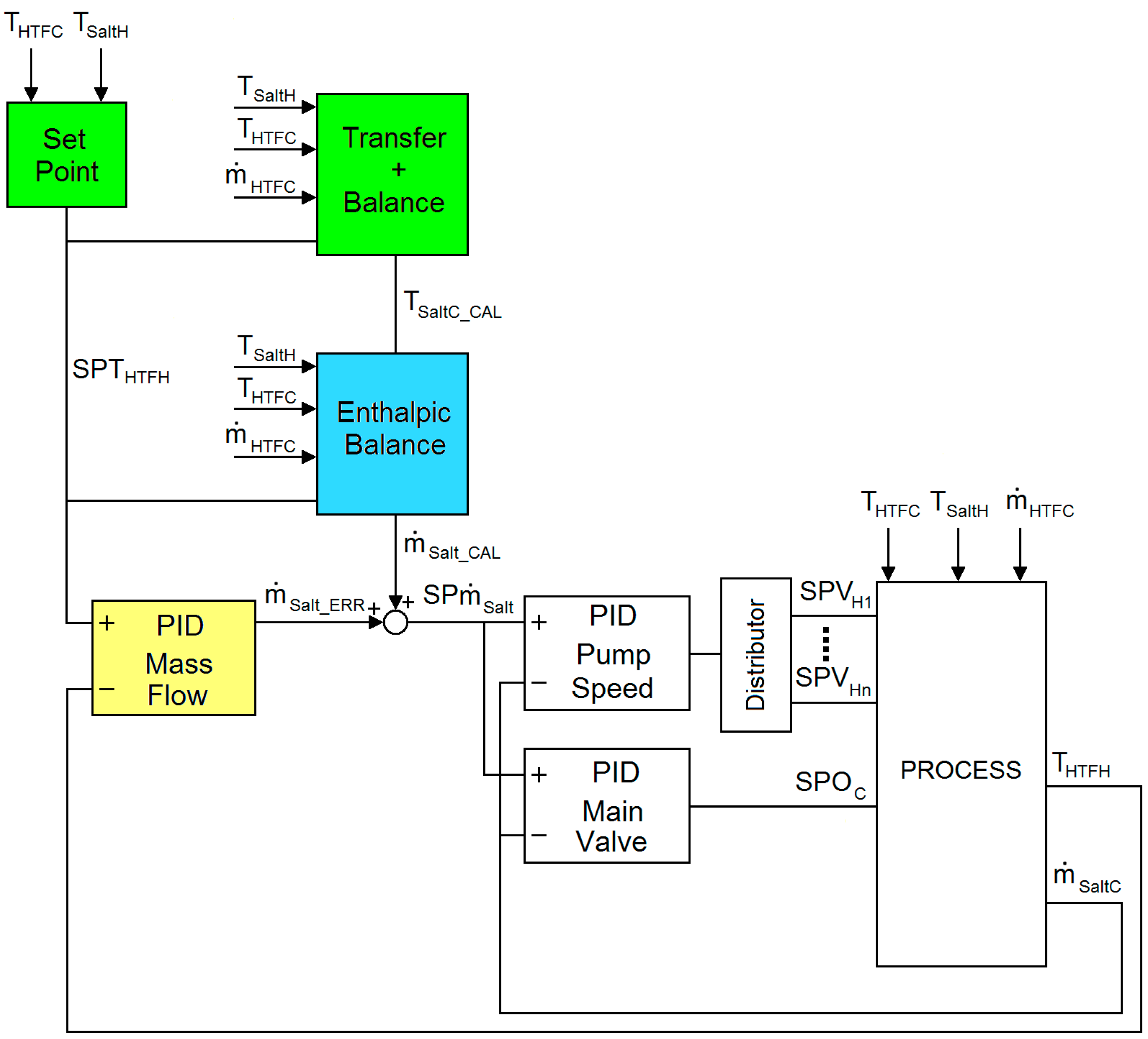
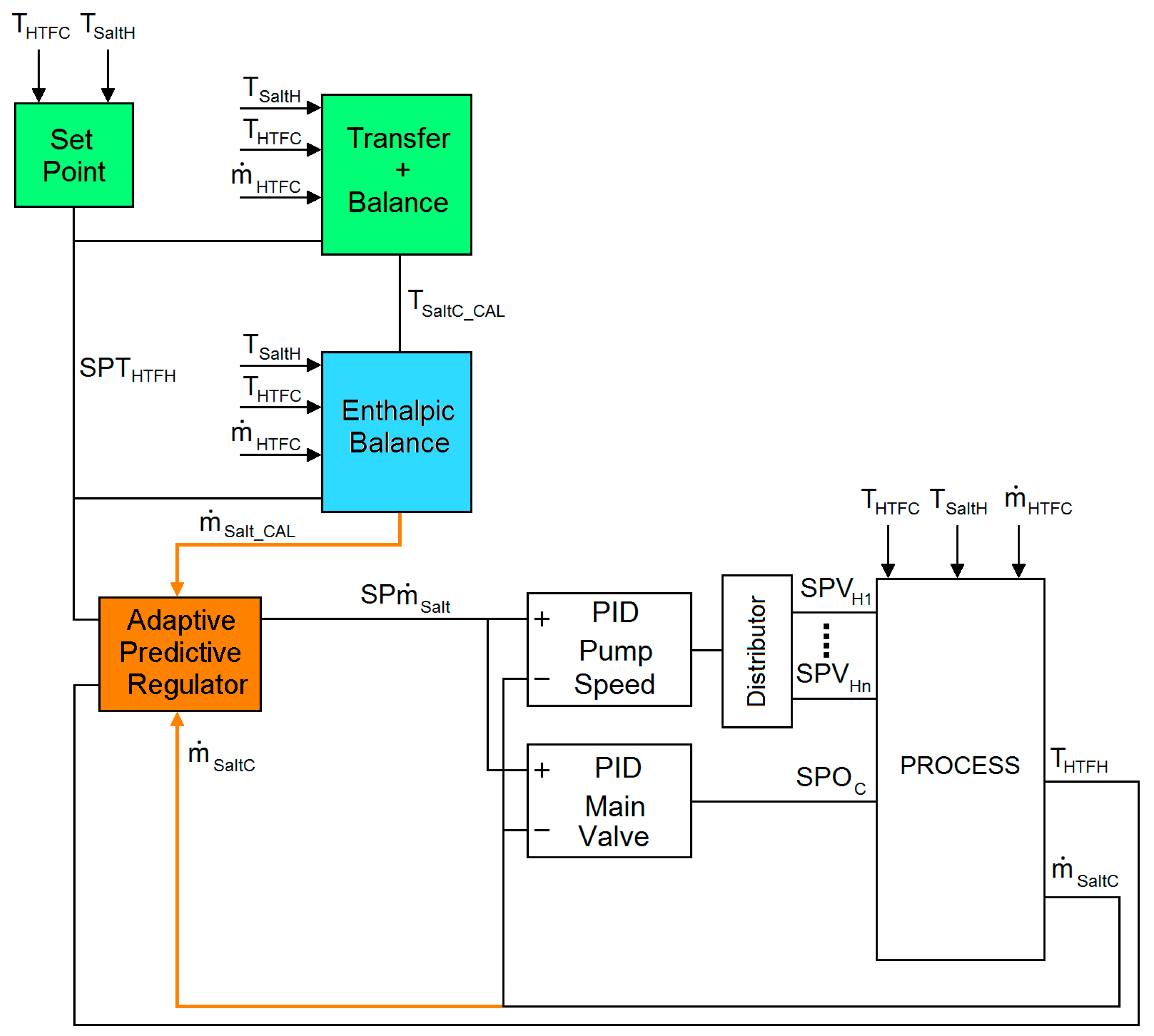
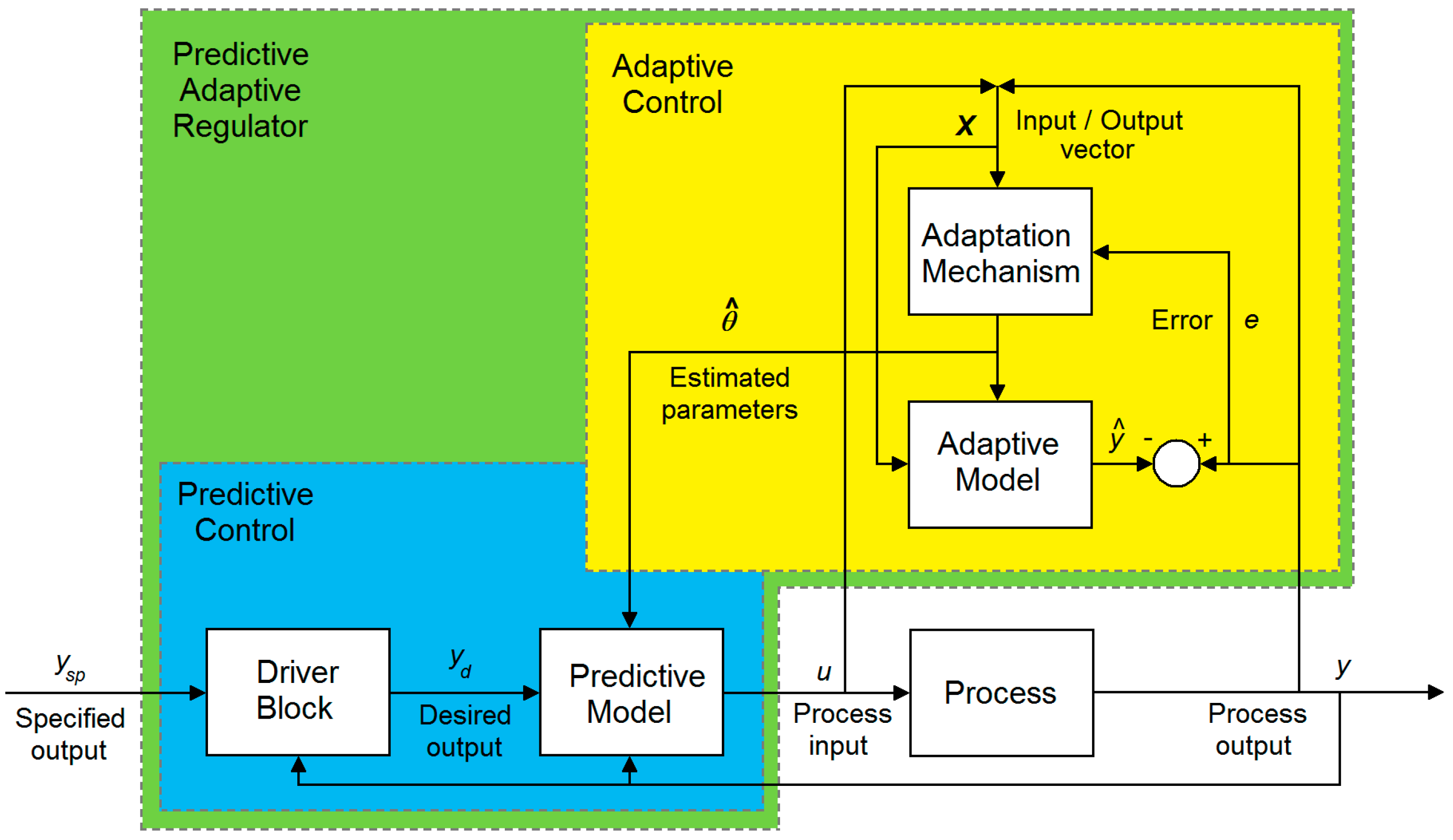
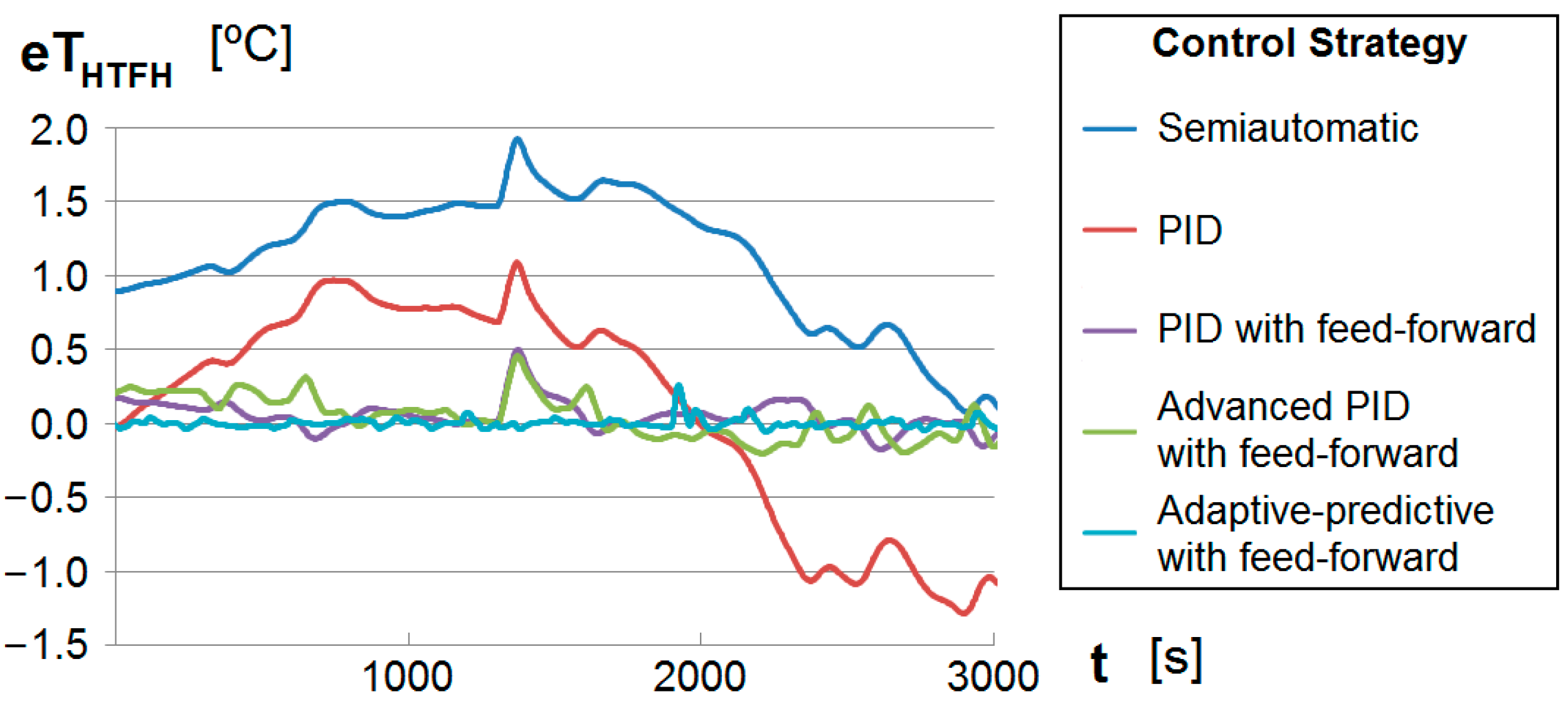

| Input Variable | Description |
|---|---|
| SPVHi | Set Point for the speed defined by the frequency converter of the i-th hot-salt pump |
| SPOC | Set Point for the opening of the main valve in the cold-salt tank |
| SPOR | Set Point for the opening of the recirculation valve |
| Perturbation | Description |
|---|---|
| THTFC | Cold HTF temperature at the input of the heat exchanger |
| TSaltH | Hot salt temperature at the input of the heat exchanger |
| HTF mass flow through the heat exchanger |
| Output Variable | Description |
|---|---|
| THTFH | Hot HTF temperature at the output of the heat exchanger (variable to control) |
| TSaltC | Cold salt temperature at the output of the heat exchanger |
| Molten salt mass flow through the heat exchanger |
| Control Strategy | eTHTFH = THTFH – SPTHTFH | |
|---|---|---|
| μ (°C) | σ (°C) | |
| Semiautomatic | 0.40 | 1.17 |
| PID | 0.20 | 0.67 |
| PID with feed-forward | 0.02 | 0.30 |
| Advanced PID with feed-forward | 0.01 | 0.13 |
| Adaptive-predictive with feed-forward | 0.00 | 0.04 |
| Control Strategy | Net Energy (MW·h) | ||
|---|---|---|---|
| Real (EN,Real) | Simulated (EN,Sim) | Difference (%) | |
| Semiautomatic | 5453 | 5458 | −0.09 |
| PID | 5522 | 5518 | 0.07 |
| PID with feed-forward | 5525 | 5514 | 0.20 |
| Advanced PID with feed-forward | 5643 | 5628 | 0.26 |
| Adaptive-predictive with feed-forward | 5721 | 5705 | 0.28 |
© 2017 by the authors. Licensee MDPI, Basel, Switzerland. This article is an open access article distributed under the terms and conditions of the Creative Commons Attribution (CC BY) license (http://creativecommons.org/licenses/by/4.0/).
Share and Cite
Prieto, M.J.; Martínez, J.Á.; Peón, R.; Barcia, L.Á.; Nuño, F. On the Convenience of Using Simulation Models to Optimize the Control Strategy of Molten-Salt Heat Storage Systems in Solar Thermal Power Plants. Energies 2017, 10, 990. https://doi.org/10.3390/en10070990
Prieto MJ, Martínez JÁ, Peón R, Barcia LÁ, Nuño F. On the Convenience of Using Simulation Models to Optimize the Control Strategy of Molten-Salt Heat Storage Systems in Solar Thermal Power Plants. Energies. 2017; 10(7):990. https://doi.org/10.3390/en10070990
Chicago/Turabian StylePrieto, Miguel J., Juan Á. Martínez, Rogelio Peón, Lourdes Á. Barcia, and Fernando Nuño. 2017. "On the Convenience of Using Simulation Models to Optimize the Control Strategy of Molten-Salt Heat Storage Systems in Solar Thermal Power Plants" Energies 10, no. 7: 990. https://doi.org/10.3390/en10070990
APA StylePrieto, M. J., Martínez, J. Á., Peón, R., Barcia, L. Á., & Nuño, F. (2017). On the Convenience of Using Simulation Models to Optimize the Control Strategy of Molten-Salt Heat Storage Systems in Solar Thermal Power Plants. Energies, 10(7), 990. https://doi.org/10.3390/en10070990






